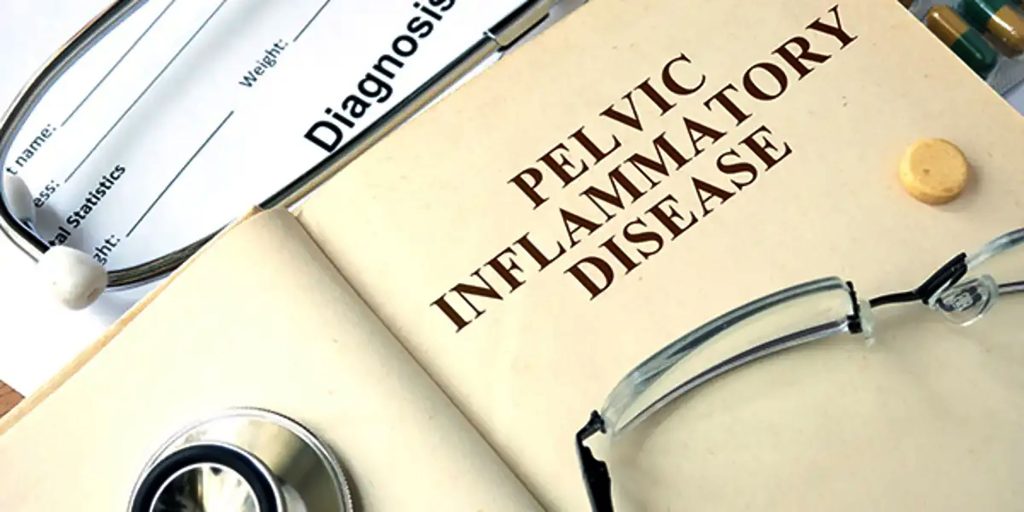Pelvic inflammatory disease (PID) is an infectious and inflammatory disorder of the upper female genital tract, including the uterus, fallopian tubes, and adjacent pelvic structures. However, once the person is infected, the infection and inflammation may spread to the abdomen, including Perihepatic structures (Fitz-Hugh−Curtis syndrome). It is one of the most common infections in women and is a common type of disorder in less developed countries.

The disease affects an estimated 4% of women, especially menstruating women younger than 25 years who have multiple sex partners, do not use contraception, and live in areas with a high prevalence of sexually transmitted disease (STD).
Table of Contents
What Are the Causes of Pelvic Inflammatory Disease (PID)?
The causes of this disease are contact-transmitted bacteria, which are Gonorrhea and Chlamydia. These include sexually transmitted diseases, viral diseases, and parasitic diseases that can affect the uterus, ovaries, and fallopian tubes in women.
What Are the Signs and Symptoms of Pelvic Inflammatory Disease?

The diagnosis of acute pelvic inflammatory disease (PID) is primarily based on historical and clinical findings. Clinical manifestations of pelvic inflammatory disease vary widely. Many patients exhibit few or no symptoms, whereas others have acute, serious illnesses.
The most common presenting complaint is lower abdominal pain. Many women report an abnormal vaginal discharge of bloody white or yellowish discharge from the uterus. Other symptoms that may occur include pain during intercourse or bleeding from the uterus during non-periods, and fever and vomiting if the infection is severe.
What Are the Things That Expose Women to Such Things?
This disease is the rex of the uterus that is most common in women aged 15 to 25 because women in this age group are more likely to have more sex. And if a woman has sex with different partners, cervical racks are more likely to appear.
For example, if any of her partners has an infection, he can easily pass it on to her. Additionally, if she has had past infections from other causes, she may experience infections again.

How to Manage the Pelvic Inflammatory Disease?
Most patients with pelvic inflammatory disease are treated in an outpatient setting. In selected cases, however, physicians should consider hospitalization. The key point is that she can be given additional help by checking for other sexually transmitted diseases such as HIV/AIDS and syphilis. The next test is an ultrasound to determine the cause around the uterus.
After all the tests, empirical antibiotic treatment is recommended for patients with otherwise unexplained uterine or adnexal tenderness and cervical motion tenderness, according to guidelines from the Centers for Disease Control and Prevention (CDC).
Antibiotic regimens for pelvic inflammatory disease must be effective against Chlamydia trachomatis and Neisseria gonorrhea, as well as against gram-negative facultative organisms, anaerobes, and streptococci.
Watch Video:
What Are the Effects that Come with the Pelvic Inflammatory Disease?
Pelvic inflammatory disease has many complications and needs to be treated as early as possible! So women with the mentioned signs and symptoms should seek immediate medical attention.
As mentioned earlier, this disease is a bacterial rex. Therefore, it is not caused by one type of bacteria but by many types and can be treated with antibiotics. The other important point is that the husband must also be treated because it is transmitted by contact, stay there, and come back again.
While you are taking the medicine, the woman should stop having sex. The main reason for treatment is repeated cervical infections and one of the long-term accompanying severe cervical pain or problems during sexual intercourse.
In addition, the rex does not egg into the fallopian tubes or uterus and can block the fallopian tubes and should be treated first. If these tubes are blocked, the main problem is the baby’s problem.
On the other hand, any woman with recurrent cervical infections should be treated to prevent them as they can cause childbirth problems. If a pregnancy occurs when these tubes are narrowed or blocked, the pregnancy may occur outside the uterus or in an abnormal place of pregnancy.

The Bottom Line
As mentioned, pelvic inflammatory disease is sexually transmitted and is especially likely to cause infection if you have sex with many partners. So, it is recommended to use protection during intercourse. People can protect themselves from this rex by using a condom or other protection methods. If married, they should be faithful and avoid having any sexual intercourse with other partners outside of marriage.
Since the disease is more common in women, especially girls aged 15 to 25, anyone with such symptoms should seek medical attention immediately. They can also get proper help at East Africa Medical Centre branches in Kampala, Uganda.
Read more health-related content here.

